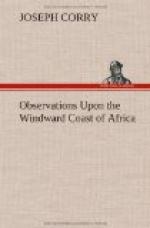From July to October, the mean temperature in the river Gambia, by Fahrenheit, has been from 90 deg. in the morning to 100 deg. at noon in the shade, and during the same months at Sierra Leone from about 92 deg. to 106 deg.; but a variety of local circumstances may give a greater or less degree of heat: this however may serve to give a general idea of the temperature of these countries. The island of Goree, for example, the island of Bance, and the bay of Sierra Leone, are more healthy, enjoying the cooling sea breezes, more than situations in the rivers more interior. The banks of all the rivers in Africa, which I have visited, are enclosed by impenetrable forests, marshes, and the closely combined mangrove tree, and it is but seldom that the land forms an uneven dry surface on their borders. Instances however in the Sierra Leone, Rio Pongo, &c. occasionally occur, when the most picturesque scenery adorns the river.
From May to August, hurricanes or tornados, before described, prevail upon the Windward Coast, and this phenomenon is to be met with from Cape Verde to Cape Palmas. The months from November to March are remarkable for the prevalence of east and north-east winds. When these winds, which are called harmatans, set in, they are accompanied with a heavy atmosphere, and are of a dry and destructive nature. Every description of vegetation is blasted by their influence, and every object, animate and inanimate, feels their powerful effects; the skin is parched and dried, and every feature is shriveled and contracted. The most compact cabinet work will give way, the seams of flooring open, and the planks even bend. Furniture of every sort is distorted; in short, nothing escapes their dreadful power. The nights at this period are cool and refreshing.
The months of July, August, September, and October are rainy, from the equator to about the 20th degree of north latitude. Towards the equinoxial they begin earlier, and make their progress to windward, but the difference throughout the whole of the north tropic fluctuates little more or less than 15 or 20 days. When the rains commence, the earth, before parched up and consolidated into an impenetrable crust, by the powerful influence of the sun and a long period of drought, is immediately covered with vermin and reptiles of all sorts, creating a moving map of putrefaction. The natives ascribe to these many of their diseases; but a further cause may be added, namely, the great change from heat to cold, and the variations at this season.
The powerful influence of the sun, which at this period is almost vertical, quickly dissipates the clouds which obscure the sky, and produces an almost insupportable effect; but new clouds soon condense, and intercept the solar rays; a mitigating heat follows; the pores are compressed, and prespiration ceases. Variations succeeding so rapidly, are attended with the most serious effects, and the most fatal consequences.




